Guyana is a country in northeast South America located along the coast of the Atlantic Ocean. Four major rivers in the country flow into the Atlantic; the Courantyne, Berbice, Demerara, and Essequibo Rivers. These rivers flow through some of the most remote rainforests of the Amazon. Some amazing lakes and wetlands, like the North Rupununi Wetlands, provide a habitat for hundreds of fish species.

You will not believe the size of some of the fish in Guyana, let alone the unique (scary) looking fish. Read on to discover 10 spectacular fish found in Guyana!
1) Arapaima

As omnivores, arapaima fish use their teeth to eat small fish, aquatic insects, and small mammals.
©Aostojska/Shutterstock.com
Probably the most notable fish in Guyana is the massive Arapaima. These heavily-scaled fish are found in the Essequibo River. The Arapaima is the largest-scaled freshwater fish in South America and can reach lengths of 10 feet or more! The average Arapaima is closer to 7-8 feet and 200 pounds, but the remote tributaries of the rivers and floodplains of the Amazon River basin provide plenty of room to grow. Besides Guyana, they can be found in Brazil and Peru. One of the most interesting facts about the Arapaima is that it can breathe air, so they do well in some areas of oxygen-deprived waters that other fish can’t survive.
The Guinness world record “heaviest freshwater fish caught on a fly” was caught in Guyana by fly fisherman Richard Hart. The arapaima he caught was 415.48 pounds! Hart caught this monster fish on February 4, 2015, while fishing on the Rewa River, a tributary of the Rupununi River in southern Guyana. Hart holds several other international fishing records, including the largest Pacu, planquettei that he caught in the same river about a year later!
2) Payara (Vampire Fish)

The Payara is the predatory fish living in a river basin Amazon, South America.
©zebra0209/Shutterstock.com
The Payara is one of the most scary-looking fish! They are sometimes called vampire fish; one look at them, and you will understand why! These fish have two long sharp fangs (really long!) that come out of their lower jaw. Their heads are awkwardly large, as well as their oversized eyes. They look scary and are scary as they are carnivorous and snack on piranhas! Clearly not a fish you want to mess with. Payara can be 2-3 feet long and weigh 10-35 pounds. They, too, can be found in the Amazon basin, but unlike the arapaima, it prefers fast-moving waters.
3) Black Piranha
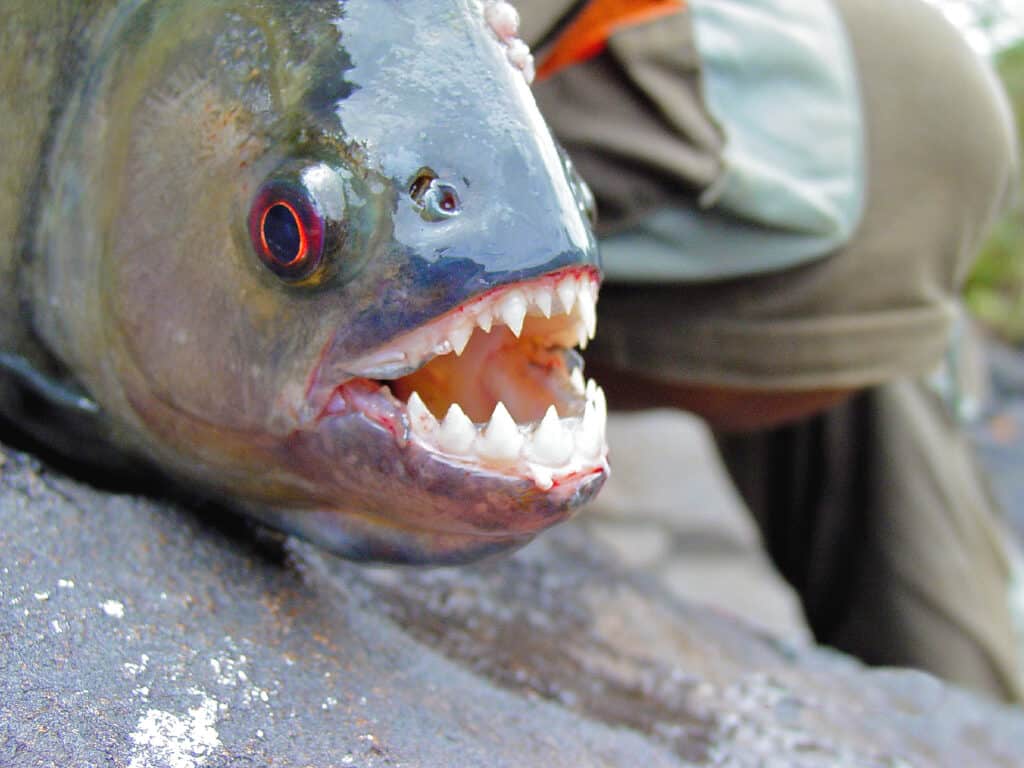
An amazon Black Piranha with an open mouth, showing its teeth.
©The Jungle Explorer/Shutterstock.com
One of the largest piranha species can be found in Guyana. The black piranha can be around 12 inches long and weigh around 10 pounds. They have almost an oval shape with a bulky build, but the most distinguishing feature is their mouth full of razor-sharp teeth. The black piranha has one of the most powerful bites, and they can repeatedly chomp and tear their prey. The reputation of a group of piranhas attacking together is actually true; they do swim in packs (called shoals). While they primarily prey on fish, they will also eat carrion if available.
4) Pacu

Piranhas have pointed razor-sharp teeth whereas the pacu has squarer, straighter teeth, that eerily resemble those of humans.
©Artex67/Shutterstock.com
Pacu are relatives of piranha but have very different-looking teeth. Their teeth are disturbingly human-looking! Their teeth are like molars used for chewing vegetation, fruit and plant debris. Pacu are sometimes called vegetarian piranhas. They are larger than piranhas, with the black pacu getting to be 3 feet long and weighing around 65 pounds as adults. Interestingly, some of the Pacu in Guyana are red pacu, named for their bright reddish-orange coloration. Red-bellied pacu are another subspecies that is silver with a red-colored belly.
5) Silver Arowana
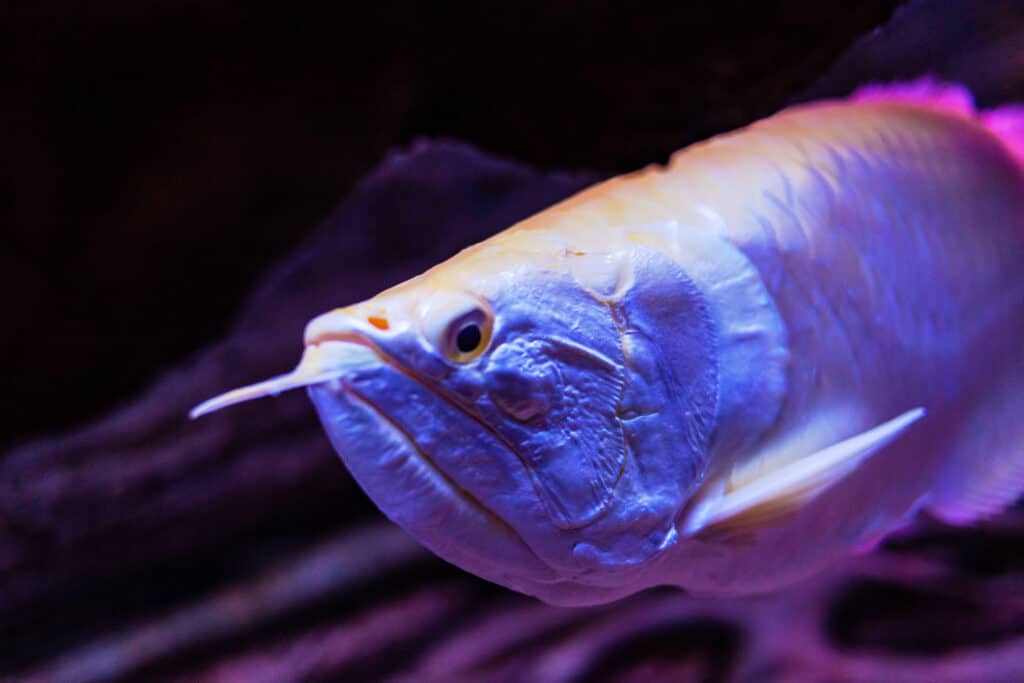
Arowana will eat small birds, large insects and even snakes!
©iStock.com/KeongDaGreat
Arowana are similar to Arapaima, with long heavy bodies covered in large silvery scales. Sometimes they are called “bony tongues” because their tongue is stiff and covered in teeth. Arowana have two barbels that stick out from their lower jaw, and it always looks like they are frowning. One of the spectacular feats of the Arowana is they can leap out of the water and snag food from branches on the shore. Imagine watching a 3-foot-long fish leap out of the water and snatch an unsuspecting bird off its perch! Arowana will eat small birds, large insects and even snakes!
6) Peacock Bass
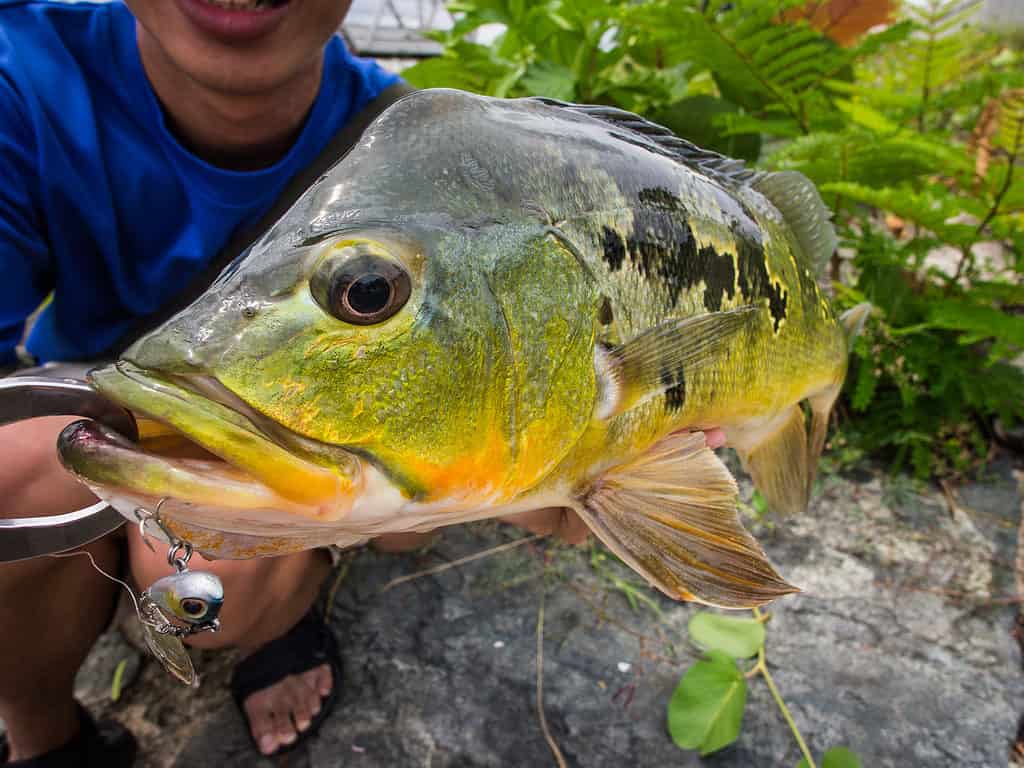
Peacock bass can reach considerable dimensions.
©Matthew Seah/Shutterstock.com
Another spectacular fish found in Guyana is the peacock bass. Although they have “bass” in their name, they are actually cichlids, but they are game fish and are served as food like North American bass. These colorful fish can be found in the Essequibo River basin in Guyana. There are several species of peacock bass, including the butterfly peacock bass, but most have similar three vertical black stripes on their green bodies with a reddish colored belly. Depending on the species, these fish can be anywhere from a foot to three feet long.
7) Piraiba Catfish
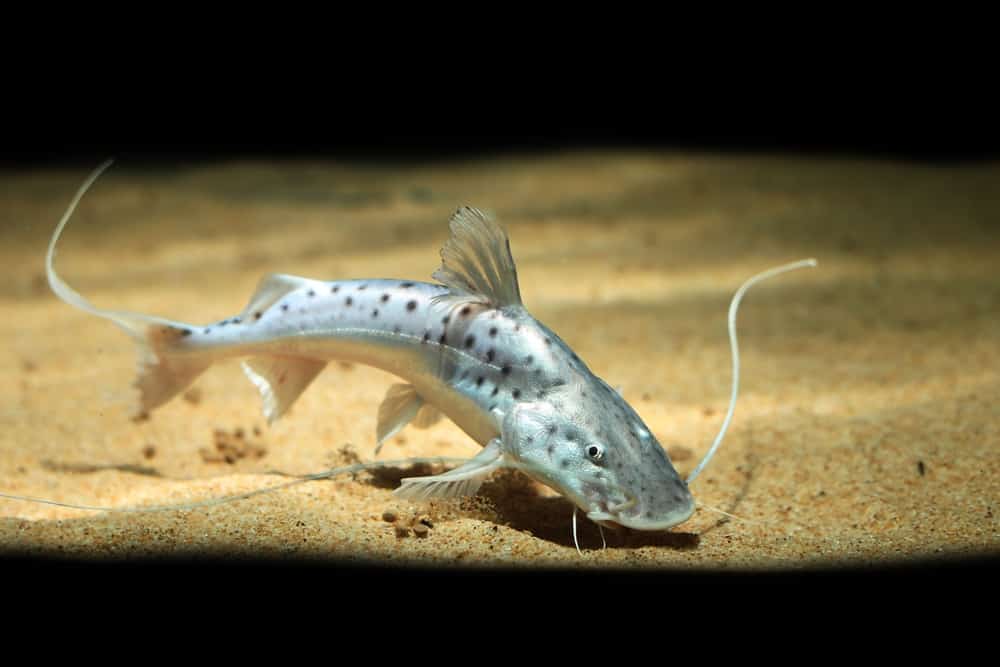
A large Piraiba
catfish
.
©Pavaphon Supanantananont/Shutterstock.com
The piraiba catfish is one of the largest catfish and is sometimes called the goliath catfish. They also go by their common name lau-lau. These catfish can be 6 ½ to 8 feet long and weigh as much as 330 pounds! Piraiba have similar whisker-like barbels on their face, making them look like cat whiskers. In Guyana, they can be found in the Courantyne River along the border between Guyana and Suriname and the Amazon River basin. The largest piraiba ever recorded was 341 pounds 11 ounces, pulled from the Rio Solimoes in Brazil in May 2009. That makes for a lot of crispy southern-fried catfish!
Another type of catfish found in Guyana is the gillbacker sea catfish. These are only found along the northeast coast of South America, including along the shore of Guyana. Gillbackers live in the muddy bottoms of wetlands and estuaries. They are one of the largest saltwater catfish and are typically around 3 feet long, but some can reach almost 6 feet. Catfish are freshwater fish, but the Gillbacker is one of the few exceptions.
8) Barracuda
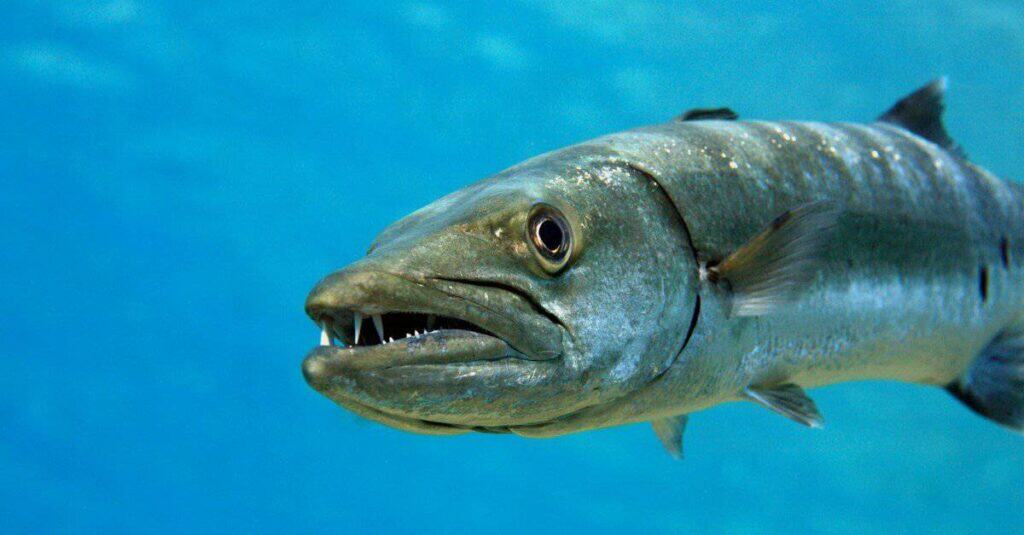
Barracuda
swimming in the ocean. Barracudas are adept hunters with few predators because of their speed and size.
©aquapix/Shutterstock.com
Besides the spectacular river monsters, Guyana has some spectacular fish out at sea. Barracuda are one of these fish. These fierce-looking fish have two rows of razor-sharp teeth and can be 6 ½ feet long. Their torpedo-shaped body helps them quickly attack prey, and they sometimes live in large schools together. They feed on smaller fish like herring, anchovy, mullets and groupers.
Although they look scary and do sometimes approach, divers attacks on humans is very rare. Barracudas can be found in shallow waters near shore and deeper parts of the ocean. They typically are not deep divers and prefer to stay closer to the surface.
9) Atlantic Tarpon
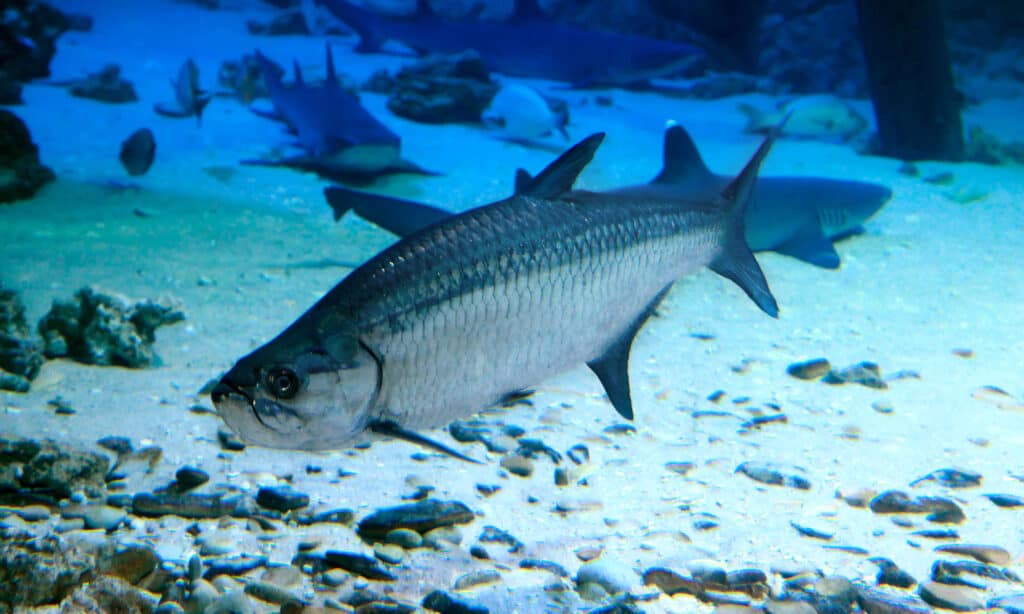
Tarpons can leap out of the water up to 10 feet in the air.
©iStock.com/TatianaMironenko
The Atlantic Tarpon is a large silvery fish, sometimes called the silver king. They average around 4 feet long, but some can be double that at 8 feet. Tarpons are a favorite game fish because of the spectacular fight they can give. Tarpons can leap out of the water up to 10 feet in the air! They also can breathe air, giving them multiple habitats they can survive, including brackish waters that are lower in oxygen. The largest tarpon ever caught was a 286-pound 9-ounce tarpon caught off the coast of Guinea-Bissau in West Africa.
10) Dorado (Dolphinfish or Mahi Mahi)

Mahi Mahi are also called dophinfish because they often swim in front of boats
©FtLaud/Shutterstock.com
Talk about spectacular. The dorado or mahi mahi fish is truly a unique-looking fish. They are easily recognizable with their oversized forehead and long body-length dorsal fin. Most are yellow with patches of neon blue spread out, but when they are caught, their color fades. They average around 3 feet long, but some can get larger. Although they are sometimes called dolphinfish, they are not related to the common dolphin or bottlenose dolphin. Dorado are fast fish reaching speeds of 40 mph.
More spectacular than seeing one is seeing a whole school of dorado swimming together. They migrate long distances, with some traveling more than a thousand miles in a month! The Dorado is one of the most spectacular fish in Guyana today!
Summary of the 10 Spectacular Fish Found in Guyana
If you visit Guyana, you can encounter these unique (and sometimes scary) fish:
| Rank | Spectacular Fish in Guyana |
|---|---|
| 1 | Arapaima |
| 2 | Payara (Vampire Fish) |
| 3 | Black Piranha |
| 4 | Pacu |
| 5 | Silver Arowana |
| 6 | Peacock Bass |
| 7 | Piraiba Catfish |
| 8 | Barracuda |
| 9 | Atlantic Tarpon |
| 10 | Dorado (Dolphinfish or Mahi Mahi) |
Up Next
- Discover 7 Spectacular Fish Found in Fiji
- 10 Incredible Piranha Facts
- The Flag of Guyana: History, Meaning and Symbolism
The photo featured at the top of this post is © iStock.com/KeongDaGreat
Thank you for reading! Have some feedback for us? Contact the AZ Animals editorial team.






